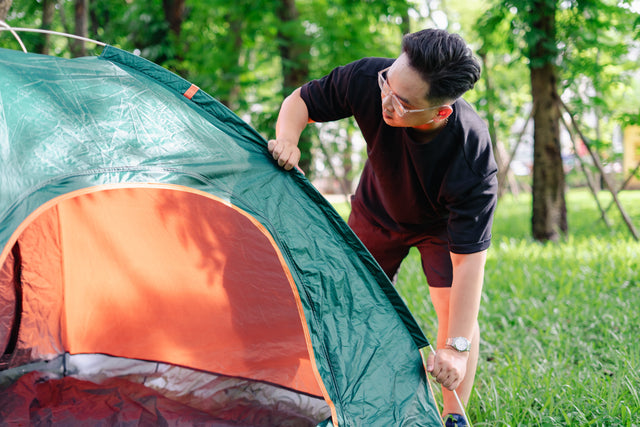Gear Care: Camping Tent Maintenance
Many of us have a special relationship with our camping tent because it serves as our home away from home in the wilderness. Most campers don't realise that simple maintenance routines can double or even triple their tent's lifespan. Regular tent care saves you money, prevents those frustrating middle-of-the-night gear failures, and we are here to show you exactly how to do that.
Why Tent Maintenance Matters
1. Protecting Your Investment
A quality tent is an investment for regular campers/hikers, and the only way to preserve your investment is to have proper camping tent maintenance. It prevents issues like premature fabric breakdown and maintains the crucial water resistance you paid for.
Think about it, would you rather spend money replacing your tent regularly or a few rands maintaining it for years to come? We know what we would choose ;).
2. Performance in the Field
A well-maintained tent will come through for you when you need it most, especially during those tough conditions. Another thing to consider is that clean ten fabric allows for proper airflow, zippers that work smoothly and watertight seams that will keep you safe through anything, come hell or high water.
3. Avoiding Common Problems
We can think of few things worse than a neglected tent that reeks of mildew, which leads to loss of water resistance and fabric degradation. Regular care prevents these issues before they ruin camping trips (and potentially your weekend).
Basic Tent Cleaning
After Every Trip Routine
We recommend starting your tent care immediately after returning from a trip. It's better to get it out of the way sooner rather than later. Start by shaking out any loose dirt and debris. You can set up your cleaning area anywhere with ample space, such as your garden or garage. We know you are probably exhausted when you get home, but trust us, you'll thank yourself in the long run.
Simple Cleaning Method
Fill a large tub with lukewarm water and add gentle soap for basic cleaning. Use a soft brush to work on stubborn spots without damaging delicate tent materials. Focus extra attention on the tent floor where dirt accumulates heaviest—that's where most of the grime tends to collect.
Rinsing and Initial Drying
Rinse thoroughly with fresh water to remove all soap residue completely. Soap left on fabric attracts more dirt and can damage the waterproof coating over time (learned that the hard way). Start the air-dry process immediately after the rinsing finishes.
Deep Cleaning Techniques
Dealing with Tough Stains
Tree sap and bird droppings need immediate attention before they set permanently (bird poop is particularly stubborn once it dries). Soak problem areas in warm water before attempting removal with gentle scrubbing. Use a non-abrasive sponge to protect fabric integrity during cleaning—you don't want to create more problems than you're solving.
Spot Clean Problem Areas
Target specific stains rather than washing the entire tent unnecessarily. Work on the tents inside areas that show mildew or moisture damage first. Clean tent sections systematically to ensure thorough coverage without missing spots (it's easy to overlook corners).
Cleaning Tent Poles Properly
Wipe tent poles with a damp cloth to remove accumulated dirt and grime. Check pole connections for debris that prevents smooth assembly and disassembly—sand and dirt love to hide in these joints. Dry completely before storage to prevent corrosion damage over time.
Proper Drying Methods
Air Dry Fundamentals
Never pack a damp tent—moisture creates perfect conditions for mildew growth, and that's a mess you don't want to deal with. Hang your tent in well-ventilated areas, away from direct sunlight, which can damage fabrics. Allow plenty of time for complete drying before storage or packing (patience is key here).
Avoiding Drying Mistakes
Heat sources damage tent fabrics and permanently destroy the waterproof coating. Ensure that the tents inside areas get adequate airflow during the drying process. Check all seams and corners for trapped moisture before considering drying complete—these spots always take longer to dry.
Complete Drying Verification
Test fabric dryness by feeling for any remaining dampness in hidden areas. Pay special attention to tent footprint sections that retain water the longest. Confirm tent poles are fully dry to prevent rust formation during storage (rusty poles are no fun to deal with).
Storage Best Practices
Creating Ideal Storage Conditions
Store your tent in a dry, well-ventilated area with stable temperatures, such as a garage or spare room. Avoid compressed packing for extended periods, as it stresses the fabric unnecessarily and can affect the tent's shape. Use breathable storage containers that protect from dust while allowing air circulation (an old pillowcase works great).
Long-term Storage Tips
Prepare tents for extended storage periods by thoroughly cleaning and inspecting them first. Store tent poles separately to prevent pressure points from developing on the fabric. Check stored gear periodically for moisture problems or pest intrusion—mice love chewing on tent fabric.
Packing Considerations
Loose packing prevents fabric stress that leads to premature wear and tear. Roll rather than stuff your tent when possible to minimise creasing damage. Store tent footprint and guy lines in separate compartments for better organisation (you'll thank yourself when you're setting up in the dark).
Repair and Maintenance
Essential Tent Repair Kit
Build a comprehensive tent repair kit for field maintenance and emergency fixes (keep it in your camping box so you won't forget it). Include seam sealer, fabric patches, and extra pegs for common repair scenarios. Keep repair supplies easily accessible during camping trips when problems arise—Murphy's law guarantees you'll need them.
Common Repair Issues
Address stuck zipper problems immediately before they worsen with continued use. Don't force it—that'll just make things worse. Apply seam sealer annually to maintain water resistance and prevent leaks from developing. Fix small tears promptly before they expand into major fabric damage.
Preventive Maintenance Schedule
Inspect seams regularly for signs of wear that require immediate attention. Test the effectiveness of the waterproof coating and reapply the treatment when water resistance diminishes. Replace worn components before they fail during critical outdoor situations (there's nothing worse than a broken tent pole in a storm).
Advanced Tent Care
Seasonal Maintenance Routines
Perform thorough tent inspections before and after each camping season. Clean your tent completely and apply fresh waterproof coating as needed. Address any developing problems during the off-season when repair shops have capacity.
Protecting Tent Fabrics
Modern tent fabrics require specific care approaches depending on their construction materials. Avoid harsh chemicals that can damage specialised coatings and treatments. Follow manufacturer recommendations for your specific tent model and fabric type.
Field Care Best Practices
Set up properly using a tent footprint protection to minimise ground contact damage. Avoid damage from strong winds by securing adequately with guy lines and extra pegs. Keep the tent clean during trips by establishing boot removal routines.
Making Your Tent Last
Investment Protection Strategies
Quality tent care ensures your gear serves reliably for many seasons of adventures. Regular maintenance prevents the need for expensive premature replacements and warranty voiding. Time invested in proper care pays dividends through extended gear lifespan.
Preparing for Your Next Adventure
Complete tent maintenance before packing for each new camping trip ensures reliable performance. Check all components function properly and replace worn items proactively. Proper preparation prevents gear failures that ruin outdoor adventures.
Or take the easier route with Naturehike, where you never have to worry about the quality of your tents and other essential camping gear. With proper camping tent maintenance, our tents will last many trips to come! Get your hiking and camping tents today on the Naturehike website.



0 Comments
There are no comments for this article. Be the first one to leave a message!